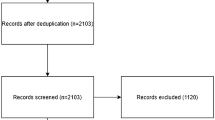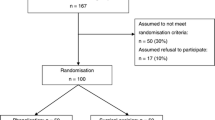Abstract
Surgical site infections occur in up to 24 % of patients after surgical excision of sacrococcygeal pilonidal sinus disease with primary wound closure. Local administration of antibiotics by a gentamicin collagen sponge could reduce this infection rate. The objective of this systematic review and meta-analysis was to evaluate the effect of a gentamicin collagen sponge on outcome after surgical excision in patients with sacrococcygeal pilonidal sinus disease. A structured literature search was performed in the PubMed, Embase, The Cochrane Library, and Scopus databases. Studies comparing surgical excision of sacrococcygeal pilonidal sinus disease with versus without a gentamicin collagen sponge were included. Outcome measures were surgical site infection, wound healing, and recurrence. The search strategy yielded six studies with a total of 669 patients. Three randomized controlled trials, comparing excision of pilonidal sinus disease and primary wound closure with versus without gentamicin collagen sponge, were eligible for inclusion in the meta-analysis (319 patients), demonstrating a trend towards reduced surgical site infections after administration of gentamicin collagen sponge [absolute risk reduction 20 %, 95 %-confidence interval (CI) 1–41 %, p = 0.06]. The wound healing (absolute risk reduction 22 %, 95 % CI 32–77 %, p = 0.42) and recurrence rate (absolute risk reduction 8 %, 95 % CI 7–22 %, p = 0.30) were not significantly different between both groups. Administration of a gentamicin collagen sponge after surgical excision of sacrococcygeal pilonidal sinus disease showed no significant influence on wound healing and recurrence rate, but a trend towards a reduced incidence of surgical site infections. Therefore, additional larger well-designed randomized controlled trials are required.


Similar content being viewed by others
References
Søndenaa K, Andersen E, Nesvik I, Søreide JA (1995) Patient characteristics and symptoms in chronic pilonidal sinus disease. Int J Colorectal Dis 10:39–42
Akinci OF, Bozer M, Uzunköy A, Düzgün SA, Coşkun A (1999) Incidence and aetiological factors in pilonidal sinus among Turkish soldiers. Eur J Surg 165:339–342
Khanna A, Rombeau JL (2011) Pilonidal disease. Clin Colon Rectal Surg 24:46–53
Al-Khamis A, McCallum I, King PM, Bruce J (2010) Healing by primary versus secondary intention after surgical treatment for pilonidal sinus. Cochrane Database Syst Rev (1): CD006213
Enriquez-Navascues JM, Emparanza JI, Alkorta M, Placer C (2014) Meta-analysis of randomized controlled trials comparing techniques with primary closure for chronic pilonidal sinus. Tech Coloproctol 18:863–872
Ates M, Dirican A, Sarac M, Aslam A, Colak C (2011) Short and long-term results of the Karydakis flap versus the Limberg flap for treating pilonidal sinus disease: a prospective randomized study. Am J Surg 202:568–573
Hull TL, Wu J (2002) Pilonidal disease. Surg Clin North Am 82:1169–1185
Søndenaa K, Diab R, Nesvik I et al (2002) Influence of failure of primary wound healing on subsequent recurrence of pilonidal sinus. Combined prospective study and randomised controlled trial. Eur J Surg 168:614–618
Kronborg O, Christensen K, Zimmermann-Nielsen C (1985) Chronic pilonidal disease: a randomized trial with a complete 3-year follow-up. Br J Surg 72:303–304
Chaudhuri A, Bekdash BA, Taylor AL (2006) Single-dose metronidazole vs 5-day multi-drug antibiotic regimen in excision of pilonidal sinuses with primary closure: a prospective, randomized, double-blinded pilot study. Int J Colorectal Dis 21:688–692
Lundhus E, Gjøde P, Gottrup F, Holm CN, Terpling S (1989) Bactericidal antimicrobial cover in primary suture of perianal or pilonidal abscess. A prospective, randomized, double-blind clinical trial. Acta Chir Scand 155:351–354
Ruszczak Z, Friess W (2003) Collagen as a carrier for on-site delivery of antibacterial drugs. Adv Drug Deliv Rev 55:1679–1698
Musella M, Guido A, Musella S (2001) Collagen tampons as aminoglycoside carriers to reduce postoperative infection rate in prosthetic repair of groin hernias. Eur J Surg 167:130–132
Andersson RE, Lukas G, Skullman S, Hugander A (2010) Local administration of antibiotics by gentamicin-collagen sponge does not improve wound healing or reduce recurrence rate after pilonidal excision with primary suture: a prospective randomized controlled trial. World J Surg 34:3042–3048
Vogel P, Lenz J (1992) Treatment of pilonidal sinus with excision and primary suture using a local, resorbable antibiotic carrier. Results of a prospective randomized study. Chirurg 63:748–753
Yetim I, Ozkan OV, Dervişoglu A, Erzurumlu K, Canbolant E (2010) Effect of gentamicin-absorbed collagen in wound healing in pilonidal sinus surgery: a prospective randomized study. J Int Med Res 38:1029–1033
Holzer B, Grüssner U, Brückner B, EMD study group et al (2003) Efficacy and tolerance of a new gentamicin collagen fleece (Septocoll) after surgical treatment of a pilonidal sinus. Colorectal Dis 5:222–227
Rao MM, Zawislak W, Kennedy R, Gilliland R (2010) A prospective randomised study comparing two treatment modalities for chronic pilonidal sinus with a 5-year follow-up. Int J Colorectal Dis 25:395–400
Moher D, Liberati A, Tetzlaff J, Altman DG; PRISMA Group (2010) Preferred reporting items for systematic reviews and meta-analyses: the PRISMA statement. Int J Surg 8:336–341
Higgins J, Green S (2011) Cochrane handbook for systematic reviews of interventions. Version 5.1.0. The cochrane collaboration. http://www.cochrane-handbook.org. Accessed 22 Feb 2014
Centre for evidence based-medicine at University of Oxford (2011) The Oxford 2011 Levels of evidence. http://www.cebm.net/wp-content/uploads/2014/06/CEBM-Levels-of-Evidence-2.1.pdf. Accessed 22 Feb 2014
Doll D, Evers T, Matevossian E, Hoffmann S, Krapohl B, Bartsch D (2011) Does gentamycin affect long term recurrence rate in pilonidal sinus surgery? Eur Surg 43:236–243
Chang WK, Srinivasa S, MacCormick AD, Hill AG (2013) Gentamicin-collagen implants to reduce surgical site infection: systematic review and meta-analysis of randomized trials. Ann Surg 258:59–65
Friberg O, Dahlin LG, Levin LA et al (2002) Cost effectiveness of local collagen-gentamicin as prophylaxis for sternal wound infections in different risk groups. Scand Cardiovasc J 40:117–125
Author information
Authors and Affiliations
Corresponding author
Ethics declarations
Conflict of interest
The authors declare that they have no conflict of interest.
Ethical approval
This article does not contain any studies with human participants or animals performed by any of the authors.
Informed consent
For this type of study, formal consent is not required.
Rights and permissions
About this article
Cite this article
Nguyen, A.L., Pronk, A., Furnée, E.J.B. et al. Local administration of gentamicin collagen sponge in surgical excision of sacrococcygeal pilonidal sinus disease: a systematic review and meta-analysis of the literature. Tech Coloproctol 20, 91–100 (2016). https://doi.org/10.1007/s10151-015-1381-7
Received:
Accepted:
Published:
Issue Date:
DOI: https://doi.org/10.1007/s10151-015-1381-7




